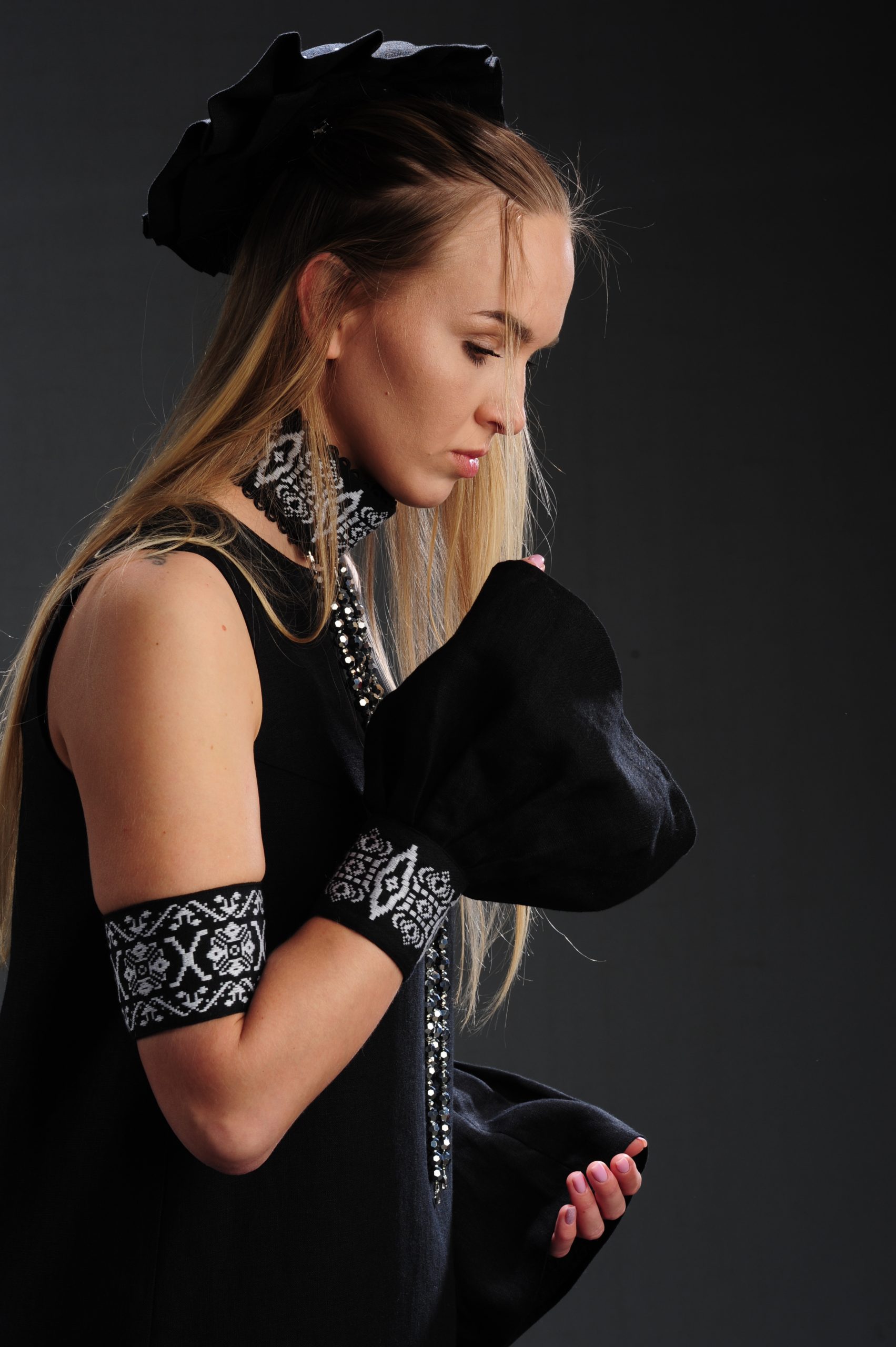Zadushki
Perebor-funeral ornament was the starting point and inspiration for „Zadushki” collection was perebor-ornament attached to garments from Włodawa area as a symbol of grief after the closest ones who passed away. What fascinates the most is the purity of the form and self-sufficiency of the perebor-ornament demonstrated in this precise style and form. There’s no playing with colours, only the ornament which needs to defend itself.


Atmosfera mistyki
“Zadushki” collection has been shrouded in mystery and mysticism of the secrecy relating to November famous polish drama „Dziady”. Decorative ornaments of the clothing are hidden in a shirt’s clasps and in dresses’ box pleats. Not clearly visible at first glance, reveal their beauty with each and every move.
Nakrycia głów
The main inspiration for headgears in each and every project were the headgears present in folk clothes from Bug district and Włodawa district. Those designs were inspired by „zwijka” which is a characteristic towel folded into three parts attached around the head and decorated with perebor-ornament, hood with the original hole at the front of the head, ‚kimbałka’ which is hoop placed on the head, through which hair were dragged and surrounded with an item called ‚okrajka’ which is a cap with drawstrings, decorated with perebor-ornament and cross-stitch embroidered.


Dodatki
Accessory used in all designs is a jewellery made of glass beads which used to be a common substitute for real corals, which only a few women could afford to buy. They appear in all designs in various forms and each and every string of beads is finished with snap hooks attached to extensively/richly located loops which created the opportunity to multiple modifications of jewellery layouts.
Perebor jako ornament
When it comes to folk clothing from Bug River areas and Włodawa areas perebor-ornament was used to be placed on the stand-up collars, yokes, shirt cuffs. In all designs the shirt has been reduced to places where ornaments occur. As a result the decorative part of each dress is respectively stand-up collar, collar, yokes decorated with perebor-ornaments.


Bawełna i len
The “Zadushki” collection was made of various weights of 100% linen and cotton looped fabrics.
Sitodruk i nadruk
Prints in presented designs are used in both forms, not only the traditional one which involves woven on looms or cross-stitch embroidered (it was a technique which finally replaced weaving on traditional looms) but also in a modern version of print referring to manual printing which used to occur as a pattern on skirts. Silkscreen was made with the use of water-based paints which is penetrating each fibre of the fabric and breathing along with it (becoming breathable material along with the fibre). There has also been used a computer cross-stitch embroidery technique in order to personalize some of the designed elements with the brand’s logo.


“Dziady”
Sylwetka prezentuje luźne nawiązanie do tradycji: kaszkiet inspirowany kapturem, bawełniane spodnie dresowe z printem autorskiego pereboru oraz lniana koszula z ukrytym w zapięciu haftem krzyżykowym. Całość uzupełnia biżuteryjny łańcuch przypięty do spodni złożony ze szklanych koralików.
“Dushyczka”
Spódnico-spodnie w projekcie Dushyczka inspirowane są spódnicą lnianą w stroju włodawskim, której tył w przeciwieństwie do przodu był plisowany, różniąc się jednocześnie od przodu występującym u dołu spódnicy ornamentem. Nakrycie głowy nawiązuje do zawijki – charakterystycznego ręcznika składanego na trzy części zawiązywanego wokół głowy wykończonego pereborem. Rysunki na bluzce w projekcie Dushyczka, które obrazują przechodzenie w dzień zaduszny dusz przez bramę cmentarną celem udania się do rodzinnych domostw, wykonane są metodą sitodruku. Dresowa spódniczka z charakterystycznym printem to jedyny element kolekcji nawiązujący do stroju krzczonowskiego.


“Melancholia”
W projekcie Melancholia stylizacja zostaje zredukowana do samych miejsc występowania ornamentów. W rezultacie sukienkę zdobią odpowiednio stójka, przyramki i mankiety zdobione pereborami zapinane za pomocą szklanych koralików. Całość uzupełniają personalizowane glany, trampki i podkolanówki nawiązujące do współczesnego i uniwersalnego obuwia. Nakrycie głowy inspirowane jest kimbałką.
“Listopadowa”
W projekcie Listopadowa stylizacja zostaje zredukowana do samych miejsc występowania ornamentów. W rezultacie sukienkę zdobią odpowiednio kołnierz i mankiety zdobione pereborami zapinane za pomocą szklanych koralików. Całość uzupełniają personalizowane glany, trampki i podkolanówki nawiązujące do współczesnego i uniwersalnego obuwia. Na głowie czepek nawiązujący do okrajki.

